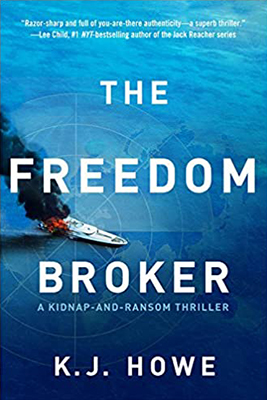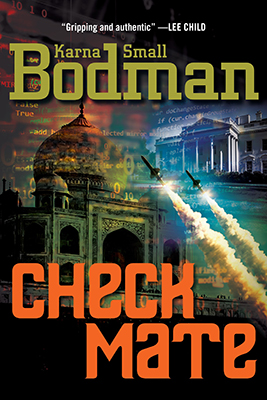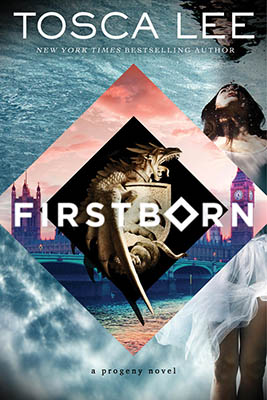By Francine Mathews
Fifteen years ago, I was drafting a spy novel entitled Blown. It was my second novel about Caroline “Mad Dog” Carmichael, a CIA terrorism analyst very much like myself, who was combatting neo-Nazis at home and abroad. The draft wasn’t going well. I was way past deadline. I’d rewritten it twice. To get out of the house and away from my computer screen, I was working out at a local fitness center and reading The New Yorker on my exercise bike. While idly flipping through the cartoons and shorter bits, my eyes were suddenly drawn to a familiar image: a runner in a Princeton University singlet pounding down the main path below Blair Arch.
I had spent four years at Princeton. So of course I was immediately intrigued by the subhead of David Samuels’ profile of James Arthur Hogue, entitled “The Runner.”
He woke up one morning and decided to become someone else.
[The profile is so artfully written that it feels like a travesty to summarize Samuels’ work. PLEASE. When you have a moment, immerse yourself in it here.]
Suffice it to say that Hogue, a “drifter, petty thief and ex-con,” successfully fabricated an identity that almost changed his life, in ways that belong only in movies. [In fact, Con Man–a 2002 documentary by Jesse Moss–tells his story.]

In his college essay, Hogue renamed himself Alexi Indris-Santana and invented European parents, sadly dead, who were artists and intellectuals. He described himself as a teenaged working cowboy on the Plains of the West, an autodidact who’d read the Great Books by firelight while sleeping under the stars. This wistful thought piece appealed to every impulse among the hardened admissions officers at Princeton: a self-taught genius, both sophisticated and rustic! A child of Nature who understood multisyllabic words, and used them correctly in a sentence! A chance to give full aid to a deserving young mind, instead of admitting yet another product of Andover or Groton! And Alexi Santana had a special gift–all those years of rugged living among cattle herds had somehow made him an athlete. He was a runner. Princeton recruited him for Track and Field.
 |
| copyright The Daily Princetonian |
Alexi Santana was nineteen. But James Hogue was nearly thirty. Becoming someone else on this scale is what is known as fraud.
He was a rousing success at Princeton both on and off the track–short on funds, of course, but intriguing enough that women thought he was dope and teammates carried him through difficult patches. It seemed odd that he was already losing his hair, but maybe that was a European thing. He was skinny enough as a runner that his age never came into question; if he looked haggard, it was attributed to excessive training. He was so accepted and his cachet was so secure that he was considered for admission to the most exclusive of the selective eating clubs on Prospect Street–the one usually reserved for members of the Ford and Forbes families and their wingmen–Ivy. Had Alexi Santana managed to graduate with a Princeton degree and those kinds of social connections, he would never have looked back.
I read “The Runner” without the kind of outrage many people, particularly Princeton grads, felt at the story. I was utterly fascinated. Because I recognized that James Hogue was destined for a brilliant career–if only he’d applied to the CIA instead of Princeton.
You see, what he had done–almost flawlessly–was created a Legend, as it’s called in intelligence operations. His alternative version of his identity was so effective that it was accepted within the community he was determined to infiltrate. He had studied his target. He had mastered the cultural expectations and norms. He had adopted the local camouflage and color, he had gone into the hostile environment with profound confidence, and he had recruited every single person he needed into total faith and belief. All of them felt betrayed, used, exploited and violated by the end of James Hogue’s run at the Ivies–but a talent that appears criminal in one setting, may actually be a job description in another. His brilliance, however amoral or sociopathic, was sadly misapplied.
 Alexis Santana was eventually blown when a Yale student who’d known him as James Hogue in Palo Alto–where he’d impersonated a teenager and run track at a local high school–outed him at the HYPs, the Harvard-Princeton-Yale Track & Field event. He was arrested by the FBI for fraud. He’s now in his fifties–still a drifter, ex-con, and petty thief, most recently booked in Boulder, CO, for stealing $1200 worth of sunglasses.
Alexis Santana was eventually blown when a Yale student who’d known him as James Hogue in Palo Alto–where he’d impersonated a teenager and run track at a local high school–outed him at the HYPs, the Harvard-Princeton-Yale Track & Field event. He was arrested by the FBI for fraud. He’s now in his fifties–still a drifter, ex-con, and petty thief, most recently booked in Boulder, CO, for stealing $1200 worth of sunglasses.
 Hogue’s story inspired a secondary character in Blown that I still love today–Raphael, the CIA’s master of legend and disguise. Some readers think he’s the point of the whole story. Some think he deserves his own. Who knows? Maybe I’ll write one for him, someday.
Hogue’s story inspired a secondary character in Blown that I still love today–Raphael, the CIA’s master of legend and disguise. Some readers think he’s the point of the whole story. Some think he deserves his own. Who knows? Maybe I’ll write one for him, someday.
Cheers!
Francine
www.francinemathews.com

 Alexis Santana was eventually blown when a Yale student who’d known him as James Hogue in Palo Alto–where he’d impersonated a teenager and run track at a local high school–outed him at the HYPs, the Harvard-Princeton-Yale Track & Field event. He was arrested by the FBI for fraud. He’s now in his fifties–still a drifter, ex-con, and petty thief, most recently booked in Boulder, CO, for stealing $1200 worth of sunglasses.
Alexis Santana was eventually blown when a Yale student who’d known him as James Hogue in Palo Alto–where he’d impersonated a teenager and run track at a local high school–outed him at the HYPs, the Harvard-Princeton-Yale Track & Field event. He was arrested by the FBI for fraud. He’s now in his fifties–still a drifter, ex-con, and petty thief, most recently booked in Boulder, CO, for stealing $1200 worth of sunglasses.  Hogue’s story inspired a secondary character in Blown that I still love today–Raphael, the CIA’s master of legend and disguise. Some readers think he’s the point of the whole story. Some think he deserves his own. Who knows? Maybe I’ll write one for him, someday.
Hogue’s story inspired a secondary character in Blown that I still love today–Raphael, the CIA’s master of legend and disguise. Some readers think he’s the point of the whole story. Some think he deserves his own. Who knows? Maybe I’ll write one for him, someday.

















































I hadn't heard of him, Francine. What a wonderful story, and no wonder you got two characters out of him. Inspirational in marvelous resourceful and creepy ways! Thanks for another great post!
Oh Francine, what a wild tale. As you said, imagine what this obviously bright and clever character could have accomplished if only he had taken a different route (perhaps as a CIA analyst like yourself) Thanks for posting!
Thanks, fellow rogues. I persist in believing Matt Damon would play Hogue well in a film version. 🙂
I am always fascinated by con man stories. I've always loved the idea of going "undercover" and putting on a persona to gather intel. I know you're supposed to create backgrounds that are easy to remember — names that come naturally; job histories and family histories that are easy to remember. I'm just not sure that I could pull it off. Sort of the "Catch Me If You Can," thing. You have to own it completely, almost believe it yourself. Fun post!
Francine, this is such an interesting story! Like you, I'm more awed than outraged at the con.